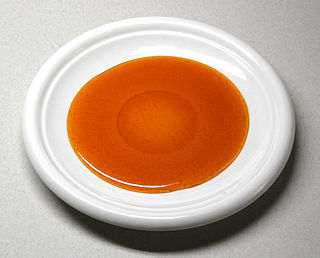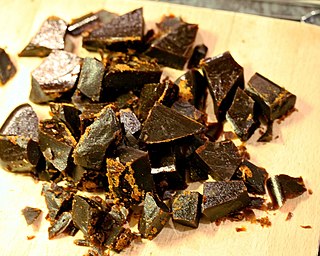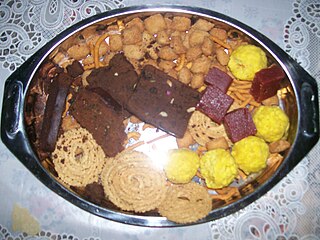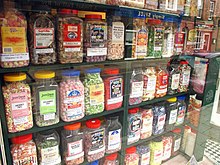
Confectionery is the art of making confections, which are food items that are rich in sugar and carbohydrates. Exact definitions are difficult. In general, however, confectionery is divided into two broad and somewhat overlapping categories: bakers' confections and sugar confections. The occupation of confectioner encompasses the categories of cooking performed by both the French patissier and the confiseur.

Caramel is an orange-brown confectionery product made by heating a range of sugars. It can be used as a flavoring in puddings and desserts, as a filling in bonbons or candy bars, or as a topping for ice cream and custard.

Fudge is a type of confection that is made by mixing sugar, butter and milk. It has its origins in the 19th century United States, and was popular in the women's colleges of the time. Fudge can come in a variety of flavorings depending on the region or country it was made; popular flavors include fruit, nut, chocolate and caramel. Fudge is often bought as a gift from a gift shop in tourist areas and attractions.

Toffee is a confection made by caramelizing sugar or molasses along with butter, and occasionally flour. The mixture is heated until its temperature reaches the hard crack stage of 149 to 154 °C. While being prepared, toffee is sometimes mixed with nuts or raisins.

Rice pudding is a dish made from rice mixed with water or milk and other ingredients such as cinnamon, vanilla, and raisins.

Tablet is a medium-hard, sugary confection from Scotland. Tablet is usually made from sugar, condensed milk, and butter, which is boiled to a soft-ball stage and allowed to crystallise. It is often flavoured with vanilla and sometimes has nut pieces in it.

Sticky toffee pudding, known as sticky date pudding in Australia and New Zealand, is a British dessert consisting of a moist sponge cake made with finely chopped dates (optional), covered in a toffee sauce and often served with a vanilla custard or vanilla ice-cream. It is considered a British classic by various culinary experts.

Bonfire toffee is a hard, brittle toffee associated with Halloween and Guy Fawkes Night in the United Kingdom. The toffee tastes very strongly of black treacle (molasses), and cheap versions can be quite bitter. In Scotland, the treat is known as claggum, with less sweet versions known as clack. In Wales, it is known as loshin du. The flavour is similar to that of butterscotch.

Scottish cuisine encompasses the cooking styles, traditions and recipes associated with Scotland. It has distinctive attributes and recipes of its own, but also shares much with other British and wider European cuisine as a result of local, regional, and continental influences—both ancient and modern.
Cottage pudding is a traditional American dessert consisting of a plain, dense cake served with a sweet glaze or custard. The glaze is generally cornstarch based and flavored with sugar, vanilla, chocolate, butterscotch, or one of a variety of fruit flavors such as lemon or strawberry.

Sussex pond pudding, or well pudding, is a traditional English pudding from the southern county of Sussex. It is made of a suet pastry, filled with butter and sugar, and is boiled or steamed for several hours. Modern versions of the recipe often include a whole lemon enclosed in the pastry. The dish is first recorded in Hannah Woolley's 1672 book The Queen-Like Closet.

Kuswar or Kuswad is a set of festive sweets and snacks made and exchanged by Christians of the Konkan region in the Indian subcontinent for the Christmas season or Christmastide. These goodies are major parts of the cuisines of the Goan Catholic community of Goa in the Konkan region, and the Mangalorean Catholic community of Karnataka. There are as many as 22 different ethnic recipes that form this distinct flavour of Christmas celebration in Goa and Mangalore. Kuswad is also made and exchanged by Karwari Catholics of Carnataca and the Kudali Catholics of Sindhudurg, in the Konkan division of Maharashtra.

Bread and butter pudding is a traditional bread pudding in British cuisine. Slices of buttered bread scattered with raisins are layered in an oven dish, covered with an egg custard mixture seasoned with nutmeg, vanilla, or other spices, then baked.
The following outline is provided as an overview of and topical guide to chocolate:














